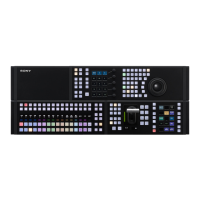95
Transition type
You can set the way in which the transition occurs.
You can select the following transition types.
Basic Operation for
Transitions
The basic transition operation flow is as follows.
1
Select a background image using the background A
bus cross-point buttons in the cross-point control
block.
2
Select the switch target of a transition.
Select a next transition using the next transition
sel
ection buttons in the transition control block.
For details about next transitions, see “Next
Transitions” (page 96).
3
Set the state for after the transition executes.
When switching the background, select a background
i
mage using the background B bus cross-point
buttons.
For details about selecting a signal, see “Chapter 4
Selecting Signals” (page 81).
When inserting a key, set the key to insert.
For details about setting keys, see “Chapter 6 Keys”
(page 116).
When changing the key overlay sequence, set the key
pr
iority.
For details about key priority, see “Key Priority”
(page 97).
4
Select a transition type.
Select a transition type using the transition type
sel
ection buttons in the transition control block.
To switch (cut) from the current image
i
nstantaneously to the new image, proceed to step
6
.
For details about transition types, see “Transition
Type” (page 99).
5
Set the transition type.
Make the required settings for the selected transition
t
ype.
• Transition rate settings (see page 101)
• Super mix settings (see page 100)
• Preset color mix settings (see page 100)
• Wipe settings (see page 149)
• DME wipe settings (see page 165)
• Clip transition settings (see page 173)
Using transition preview mode, you can check the
exec
ution of the transition.
Transition type Description
Mix The new image progressively
fad
es in over the current image.
The sum of the two image outputs
is maintained constant, and the
output of each is at 50% at the
mid-point of the transition.
NAM (non-additive
mi
x)
The current image and new image
are compared, and the image with
the higher luminance level is given
priority in the output. The output of
each is at 100% at the mid-point of
the transition.
Super mix The current image output is held at
100
%, and is mixed with the new
image. The output at the mid-point
of the transition can be 0% to
100%.
Preset color mix A color matte (plain image) is
ins
erted during the transition,
where the current image is
switched to the new image in a
two-stage transition.
Wipe The current image switches to the
new
image using a wipe pattern.
DME wipe The current image switches to the
n
ew image using a DME wipe
pattern.
Clip transition Plays back frame memory video
co
ntent linked to a mix or wipe
transition.
Cut The current image switches
ins
tantaneously to the new image.

